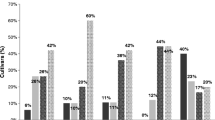Summary
Neck nodes of eight rice genotypes were inoculated with a virulent isolate of the blast pathogen at four slightly different, increasingly older stages of panicle development shortly after flowering. Resistance to infection as well as resistance to growth of the pathogen after infection was assessed. Significant differences between genotypes were found for both components of resistance. Resistance to growth of the pathogen sharply increased with aging of the neck node as was indicated by a large reduction of the length of the lesions on the culm, but resistance to infection did not change much. The lesion length was closely related to yield loss. A small delay in time of infection can lead to a large decrease in yield reduction. Meaningful comparison of partial resistance to neck blast between genotypes therefore requires infection at an identical stage of panicle development. In the field, where panicles are in different stages of development, selection of genotypes that do show the symptoms of neck blast together with relatively little yield loss in infected panicles is recommended.
Similar content being viewed by others
References
Ahn, S.W. & A. Mukelar, 1986. Rice blast management under upland conditions. In: F. Shideler & C.V. Mendoza (Eds), Progress in Upland Rice Research, pp. 363–374. IRRI, Manila, Philippines.
Amin, S.M., 1983. Neck rot infection in rice: varietal resistance, panicle phenology and yield reduction. Mardi Res. Bull. 11: 79–83.
Bonman, J.M., B.A. Estrada & J.M. Bandong, 1989. Leaf and neck blast resistance in tropical lowland rice cultivars. Plant Disease 73: 388–390.
Goto, K., K. Hirano & K. Ohata, 1961. Susceptibility of leaf of rice to blast in relation to leaf age and position. 1. Variation of susceptibility among different leaf positions and grades of emergence of the top leaf. Spec. Bull. Okayama. Pref. Agric. Exp. Stn. 58: 77–88.
Hwang, B.K., Y.J. Koh & H.S. Chung, 1987. Effects of adult plant resistance on blast severity and yield of rice. Plant Disease 71: 1035–1038.
Jeanguyot, M., 1983. Lutte contre la pyriculariose du riz. Mémoires et Travaux de 1′ IRAT no. 2. IRAT, Nogent-sur-Marne, France. 55 pp.
Kahn, R.P. & J.L. Libby, 1958. The effect of environmental factors and plant age on the infection of rice by the blast fungus, Piricularia oryzae. Phytopathology 48: 25–30.
Katsube, T. & Y. Koshimizu, 1970. Influence of blast disease on harvests of rice plants. 1. Effect of panicle infection on yield components and quality. Bull. Tohoku Natl. Agric. Exp. Stn. 39: 55–96.
Notteghem, J.L. & G.M. Andriatompo, 1979. Étude de quelques facteurs de la résistance horizontale du riz à la pyriculariose. Agron. Trop. 34: 180–195.
Ou, S.H., 1985. Rice diseases. 2nd edition. Commonwealth Mycological Institute. Kew, Surrey, England. 380pp.
Parlevliet, J.E., 1981. Race-non-specific disease resistance. In: J.F. Jenkyn & R.T. Plumb (Eds), Strategies for the control of cereal disease, pp. 47–54. Blackwell Scient. Publ., Oxford, UK.
Parlevliet, J.E., 1983. Can horizontal resistance be recognized in the presence of vertical resistance in plants exposed to a mixture of pathogen races? Phytopathology 73: 379.
Prabhu, A.S. & J.C. de Faria, 1982. Relacionamentos quantitativos entre brusone nas folhas e paniculas e seus efeitos sobre enchimento e peso dos graos em arroz de sequeiro. Pres. Agopec. Bras. 17: 219–223.
Roumen, E.C., 1992. Effect of leaf age on components of partial resistance in rice to leaf blast. Euphytica (in press).
Roumen, E.C., J.M. Bonman & J.E. Parlevliet, 1992. Leaf-age related partial resistance to Pyricularia oryzae in tropical lowland rice cultivars as measured by the number of sporulating lesions. Phytopathology 82 (in press).
Shindo, K. & K. Asaga, 1989. Studies on new method to evaluate panicle resistance of rice varieties to rice blast. Bull. Tohoku Natl. Agric. Exp. Stn. 80: 1–51.
Takasaki, T., 1988. Relationship between infection time of neck node blast in rice plant and symptoms or yield reduction by the disease. Bull. Fukuoka Agric. Res. Cent. Series A 8: 23–28.
Willis, G.W., R.D. Allowitz & E.S. Menvielle, 1968. Differential susceptibility of rice leaves and panicles to P. oryzae. Phytopathology 58: 1072 (abstract).
Author information
Authors and Affiliations
Rights and permissions
About this article
Cite this article
Roumen, E.C. Partial resistance to neck blast influenced by stage of panicle development and rice genotype. Euphytica 64, 173–182 (1992). https://doi.org/10.1007/BF00046046
Received:
Accepted:
Issue Date:
DOI: https://doi.org/10.1007/BF00046046




